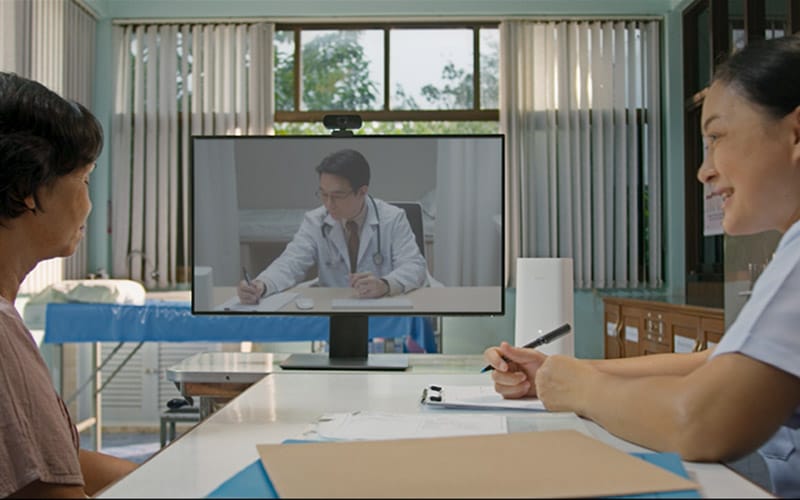National Telemedicine Center of China: Reaching Out with Fast Medical Services

The issue of unequal healthcare resources is a global problem that particularly affects people in rural and remote areas. The densely populated province of Henan in China is no exception, with the bulk of the province's healthcare resources concentrated in big cities.
However, since 2018, the telemedicine system deployed by the National Telemedicine Center at the First Affiliated Zhengzhou University Hospital has covered the whole of Henan, providing people in remote areas with top-tier medical services.
Controlling Coronavirus with Remote Diagnosis


Henan, a densely populated transportation hub and neighbor to Hubei, China's virus epicenter, was also hit hard by the coronavirus.
To build a remote diagnosis system for fighting COVID-19, Huawei teamed up with the National Telemedicine Center, completing system set up in just four days and connecting 147 hospitals specifically designated to deal with the virus across 108 counties and 18 cities. The system was able to allocate resources, conduct remote diagnosis, share treatment solutions, and provide treatment guidance during the outbreak.
The system made high-quality medical resources available to remote areas and enabled patients and medical centers in towns and counties to get help from large hospitals, improving response and decreasing the risk of cross infections due to patient transfer.
As of March 20, 2020, expert teams had used the telemedicine system to diagnose more than 2,000 cases of the coronavirus in towns and counties. The system was also used to remotely check patients in isolation wards and organize online workshops with coronavirus experts, greatly improving the capabilities of smaller hospitals to fight COVID-19.

-
147
connected hospitals designated to treat COVID-19
-
2,000+
diagnosed COVID-19 patients
Remote Expert Services for Villages
Wugang, a city 219 kilometers away from Zhengzhou, has just 19 doctors. And in the nearby village of Liangzhuang, 40-year-old Doctor Chai is responsible for treating all 1,687 villagers.
In the past, Doctor Chai only had a stethoscope to diagnose certain illnesses and patients had to visit a county hospital for an ECG or CT scan. In 2017, Doctor Chai began using a remote ECG monitoring system. Experts in county hospitals could then provide real-time diagnosis for patients based on the data he uploaded. In one case, a remote expert discovered life-threatening myocardial damage in a 50-year-old villager, and Doctor Chai was able to instruct her to go to the county hospital as soon as possible.
Villagers no longer have to make long trips to county-level hospitals and endure long waits and high costs.
Telemedicine consultations also give auxiliary medical personnel direct medical guidance. To train them, the National Telemedicine Center delivers at least four lectures each week, plus one medical case discussion and one live surgery broadcast every two weeks.
The telemedicine system in Henan enables the diagnosis and treatment of 90 percent of diseases at county-level hospitals. Auxiliary medical personnel can treat simpler conditions and refer serious cases to provincial-level hospitals – a hierarchical diagnosis and treatment model that uses resources much more efficiently.
The system provides telemedicine services for more than 500 medical centers in Henan and over 900 outside Henan, as well as covering hospitals in Zambia and Morocco. Each year, the platform handles more than 40,000 multidisciplinary diagnoses and over 500,000 specialized diagnoses, including ECG, pathology, and imaging. It also enables more than 300 remote training sessions for over 500,000 medical personnel annually.
-
40,000+
remote multidisciplinary diagnoses per year
-
500,000+
remote specialized diagnoses per year
Telemedicine Beyond Borders


The First Affiliated Zhengzhou University Hospital includes one of the medical teams that provides on-site medical assistance in Africa. With a remote consultation system, experts from China can connect face-to-face with Zambian doctors – an African nation that suffers an acute shortage of medical resources – for remote training, diagnosis, treatment, and the live streaming of surgeries.
In September 2016, Catherine, a 54-year-old female patient in Zambia, had suffered a chronic illness for five years. She felt fatigued most of the time, and couldn't even turn over in bed. Her condition was gradually worsening. To treat Catherine, the teams used the remote consultation system to connect experts in China with experts from Zambia's Levy Mwanawasa General Hospital. As a result of additional diagnostic opinions for Catherine's condition, the team developed a new diagnosis and treatment plan.









